Santa Fe is Hyundai’s Latest Leap Into Future
By John Gilbert
Just when you think you have Hyundai all figured out, the South Korean car-maker-in-a-hurry turns your perceptions upside down. Again.
Hyundai made a corporate decision that after pretty well mastering the art of delivering small and medium cars that performed at about a class above while priced at about a class below expectations and market levels, the worldwide trend toward SUVs demanded attention. It was a logical progression for Hyundai, whose sales had jumped to 46 percent small SUVs.
To expand its fleet, about a year ago, Hyundai brought out the compact Kona, an amazing vehicle that won our award for New Car Pick of the Year for 2019. We are continuing an extended test of a Kona Ultimate, and we continue to be thoroughly impressed. Kona also won the International Utility of the Year at the Detroit Auto Show and has captured virtually every award within its grasp.
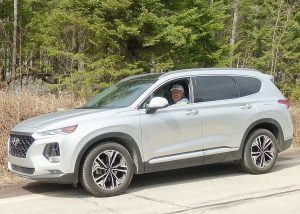
Author won’t give up the wheel, so No. 1 aide Jack Gilbert manned the camera. (Photo: Jack Gilbert.)
In its haste to fill every niche, Hyundai also completely redid its Santa Fe midsize SUV. The new Santa Fe is a totally different vehicle for 2019, made more compact than the outgoing Santa Fe but still leaving a nice space above the Tucson, which remains above the Kona. Nice, three-step size range, from Kona to Tucson to Santa Fe, each with its own personality and all three benefitting from Hyundai’s technology, safety and features, yet still aimed at economy and durability.
When they thought nobody was looking, Hyundai snuck out more new SUVs, a smaller one than the Kona, another mid-sizer, and a larger SUV bigger than the Santa Fe X. But wait! We can’t keep up. And even Hyundai doesn’t seem able to keep up with its own design and marketing traffic jam, so to speak.
While the Kona was winning all those SUV-of-the-year awards, the Santa Fe was virtually ignored, even from the time of its own introduction. The Santa Fe I wrote about at its introduction in the Utah mountains near Park City was nearly perfect from the standpoint of power, efficiency and technology. If you thought the old Santa Fe or Santa Fe XL were too big, and that the Kona was a little bit tight, the new Santa Fe plugged in perfectly. And it is good enough that it deserved some consideration itself for SUV of the year.
Several months have passed, and now the Santa Fe has gotten beyond its introduction and can be found in showrooms nationwide. But up here in Northern Minnesota, late winter has been perfect timing. This has been the winter that never ended, with a new snowstorm threatening to show up on the first weekend in May. Kentucky Derby in Louisville, shoveling anew in Duluth. Why wouldn’t you want an SUV with all-wheel drive?
So before we expand our consciousness to incorporate the reality that Hyundai now has seven — count ’em, 7 — SUVs under its name, let’s give the Santa Fe its due.
Design-wise, Hyundai had used a signature six-sided grille for long enough that it became a corporate signature SUVs and similarly on sedans. But Hyundai is still young enough in the century-plus-old business that it’s allowed to make design and even concept changes. New designers have been hired, and the latest plan is to make different vehicles look different, from each other as well as from corporate sibling Kia.
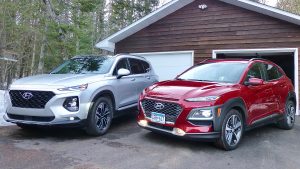
Bigger brother Santa Fe, left, shares styling tendencies first used on smaller 2019 Kona, right. (Photo: Jack Gilbert.)
The subcompact Kona came out with a startling new look, especially to its front end, where it has a completely different headlight arrangement, styled into a completely different grille plan. It caught you off-guard at first, and looked unusual but not unpleasant, until I got a look at first renderings of the coming Santa Fe. Now it makes some sense.
Hyundai was going to give the new Santa Fe front and rear styling that would make it similar to the Kona. It was a brilliant move, because it not only shook off any semblance of stodginess from the old Santa Fe, but it also blunted the off-the-chart and possibly polarizing appearance of the Kona. They are brothers-in-arms, as you can see from the photo of the bigger brother Santa Fe alongside the littler brother Kona.
Strangely, to me, Hyundai did not totally redesign the in-between Tucson, choosing instead to give it what they call a “facelift,” which is corporate-speak for changes so slight that a slight refinement to the established grille, leaves it looking nothing like the new-breed Kona and Santa Fe. In my suspicious mind, I think that’s a hint that change will be coming, and maybe soon, to the Tucson.
Another clue is that the Tucson is powered by your choice of either the tried and true 2.0 or 2.4 four-cylinder engines — neither of which benefits by Hyundai’s new-found confidence in turbocharging. The smaller Kona has the naturally-aspirated 2.0, and also a high-tech 1.6-liter turbocharged four that kicks out over 190 foot-pounds of torque, and hauls the little Kona around with style and spunk.
Santa Fe, on the other hand, also offers a pair of engines. One is the 185-horsepower/178-foot-pounds-of-torque 2.4-liter engine, and the other is a distinct upgrade to the 2.0-liter with a turbocharged version that offers 235 horsepower and 260 foot-pounds of torque. Once again, Hyundai crosses up conventional thinking by giving the smaller-displacement 4 more power than the larger one, through the magic of turbocharging.
The Santa Fe Ultimate 2.0T in the test vehicle also has Hyundai’s own 8-speed automatic that shifts smoothly and efficiently in all conditions. As an auto journalist, I am required — by me — to find any problems I can in the name of balance. I want the same transmission with steering-column paddles for manual override on specific shifting ideas. Same with the Kona, although I must add that both vehicles shift very efficiently on their own.
Santa Fe also contains the full suite of safety and driver-alert features for lane changing, blind-spot detection, front and rear warnings including pedestrian alerts, and it also has the capability to set driving mode for Normal, Comfort, Smart or Sport. They are self-explanatory, and they work to adjust the Santa Fe’s attitude. Shift points, along with steering and cornering suspension, are altered by your setting of choice.
Best of all, Santa Fe has the feature I first discovered in the mountains of Utah, and was pleased to rekindle the relationship when the terrain turned to the pothole-dotted and wintry conditions in the mountainous hills of Duluth and the North Shore of Lake Superior: Lane-assist, which also can be set to different applications.
You can set it to warning if you’re wandering across the dotted center line or the stripe on the right shoulder. You can turn it up a notch so that it warns and gently pressures the steering wheel to guide you back into your lane. And if you go most intense, it becomes lane-centering, and it does actually keep you aligned on a vector that help you stay at the center of your lane.
My wife, Joan, loves that feature she first experienced on the Kona — where it also adds to the surprising value of the smallest Hyundai SUV. She sometimes experiments, and has inspired me to do the same. Driving along a well-marked highway with no traffic, make sure the settings place the driving mode in Sport and the lane-assist to its most intense, then take your hands off the steering wheel at moderate speed. Keep your hands close, and remember, I don’t recommend this, but it makes for a fascinating experiment in this era of autonomous cars soon to come.
With your hands at the ready, you ease into a curve and the Santa Fe will gently and smoothly follow a proper trajectory around an upcoming curve to the left, and then the next one back to the right, straightening where the road straightens. It doesn’t want you to get too comfortable, though, to the point of being complacent. So after a few seconds with your hands ready but not touching the steering wheel, the instrument pod comes alive to say “No grip detected on wheel!” If you don’t grip the wheel, it quickly advances the warning to a command: “Put your hands on the wheel!” Noncompliance causes it to suggest it will shut down the feature if you don’t putyour paws where they belong.
You can’t beat that. You could turn off the feature, but why would you? It gives you proper alert and then warning, and if you had a moment of inattentiveness, it could prevent a serious accident. It also will warn you and then slow you toward an intended stop if its computers, radar, sonar and what-all decide you are not planning on avoiding that problem in your path.
Anyone who says that’s taking control is saying that they would rather have an occasional fender-bender — or worse — in the name of maintaining your personal macho command, or lack of same.
The price of the Santa Fe ranges from the high $20,000 range to the upper reaches of the $30,000 range. Its amazing safety features are all wrapped up inside a leather and soft-touch fabrics everywhere in the interior, and the bucket seats are supportive and luxurious to the touch. The rear seat has a 60-40 fold-down arrangement, where you can flip the seat down and it goes down to make a flat elongation of the carpeted rear stowage area.
Technical advances to the 2.0 Turbo engine are subtle, including electronic rather than hydraulic valve actuation, a multi-plate torque converter, the 8-speed replacing the 6-speed automatic with improved low-end and high-end ratios, the H-Trac all-wheel drive system with an electric servo control, torque-vectoring front and rear to conspire with the driving mode and lane-centering to keep you in line and give you a tremendous sense of confidence in your cornering. Altogether, Hyundai says, the system moves from being reactive to predictive.
Improved steering and suspension geometry and components make for a smooth and insulation added to the fenders, transmission tunnel and various places on the floor, as well as thicker laminated glass and variable-density seats enhance comfort. Automatic LED headlights are bright and impressive, and auto-start is a great cold-climate item, as well as the automatic stop-start.
One unique feature is safe-exit assist, with the blind-spot assist on the side preventing the rear door on that side to be opened from the inside because the system has detected an approaching vehicle. Infinity premium audio, large 8-inch multimedia screen, Blue Link, and Clari-Fi music restoration, and a unique feature to prevent small kids or pets from being trapped inside. If the car is locked, any critter that moves enough to be detected causes you to get an alert on your smartphone, and will add honking its own horn if you don’t rectify the problem immediately.
That’s another good reason to prevent little Jimmy from leaving his pet snake under the back seat.
In reality, the Santa Fe replaces the former Santa Fe, while the Santa Fe XL continues unchanged for those who have to have a third row seat. That one has the old-style but still neat Tucson-like grille, but as it sells out, don’t be surprised if the Santa Fe XL goes away to be replaced by Hyundai’s newest larger SUV. Whatever, consumers are left with only the very capable, very sporty, and very high-tech Santa Fe.


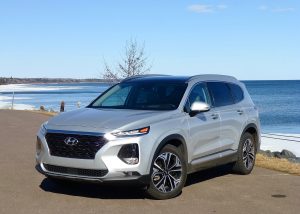
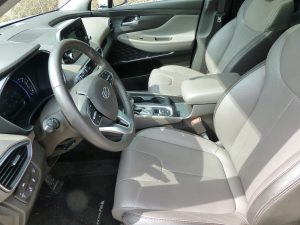
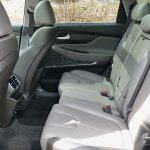
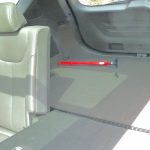
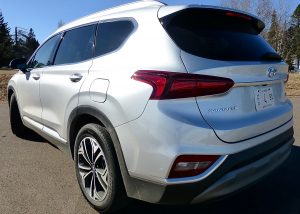
 John Gilbert is a lifetime Minnesotan and career journalist, specializing in cars and sports during and since spending 30 years at the Minneapolis Tribune, now the Star Tribune. More recently, he has continued translating the high-tech world of autos and sharing his passionate insights as a freelance writer/photographer/broadcaster. A member of the prestigious North American Car and Truck of the Year jury since 1993. John can be heard Monday-Friday from 9-11am on 610 KDAL(www.kdal610.com) on the "John Gilbert Show," and writes a column in the Duluth Reader.
John Gilbert is a lifetime Minnesotan and career journalist, specializing in cars and sports during and since spending 30 years at the Minneapolis Tribune, now the Star Tribune. More recently, he has continued translating the high-tech world of autos and sharing his passionate insights as a freelance writer/photographer/broadcaster. A member of the prestigious North American Car and Truck of the Year jury since 1993. John can be heard Monday-Friday from 9-11am on 610 KDAL(www.kdal610.com) on the "John Gilbert Show," and writes a column in the Duluth Reader.